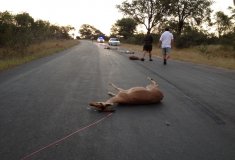There is growing recognition in many countries that roadkill is a real threat to a variety of species. The Endangered Wildlife Trust formed the Wildlife & Transport Programme (WTP) in 2012 to address identified concerns which include raising awareness of the threat to wildlife from roads and road users, and to identify, develop and implement relevant mitigation strategies. As a result of raised public awareness, protected areas have been highlighted as areas of particular concern for roadkill.
South Africa’s protected areas (which include National, Provincial and Municipal Parks) are the prime custodians of biodiversity, intended for the conservation of flora and fauna and ecosystems, but may also be valuable historical, cultural heritage or scientific sites. Tourism in protected areas is an important revenue earner, currently accounting for 7.9% of GDP and supporting one in every 12 jobs in South Africa. With approximately 10 million visitors per year (of which 2 million are from overseas), wildlife is highly sought after by visitors. South Africa includes eight World Heritage Sites and 21 national parks, with 6.9% of the country under formal protection. Tourism is expected to generate an annual contribution of US$56 billion by 2020, placing the country’s transport network under increasing pressure to meet the travel demands of tourists. A balance between the need for an efficient transport network to support the tourism industry in protected areas and a sustainable environment is therefore a challenge.
Some parks receive a high volume of vehicle traffic and this has potential consequences for wildlife as a result of wildlife-vehicle-collisions. Social media platforms have revealed public concern about the rate of roadkill in parks, including issues related to speeding and careless driving, and the conservation impacts and wildlife welfare risks such driving poses. Social media reporting is a relatively recent initiative, and the level of concern prior to its existence is largely unknown. Road mortality is probably the best known and most visible impact roads have on wildlife. However, the indirect effects of roads, while less apparent, are of equal concern. Roads may create unstable metapopulations by fragmenting habitat, restricting animal movements and increasing the functional isolation of populations. In addition, vehicle emissions contribute to air pollution, and rainwater run-off tends to pick up petrol, motor oil, and other pollutants resulting in water pollution, which all indirectly impact wildlife populations.
The WTP is excited to announce one of its new projects for 2014…. And you can assist the research team with collecting and submitting data on roadkill, thus making a valuable contribution to this project.
How can you help?
One way in which you can help, is through the collection of field data to improve our understanding of the threat and identify important sites for mitigation. Using volunteers or ‘amateur’ scientists to assist with data collection is increasingly recognised by wildlife researchers as a support to expert data collection. Citizen Science, as it is usually termed, is a form of data collection by non-professionals that can have huge benefits. In this study, the importance of data collection by the public is twofold: firstly it will greatly expand the geographic scope of the study enabling the comprehensive identification of ‘hotspot’ areas in protected areas, and secondly, it will improve our knowledge of the impacts of roads so that effective mitigation measures can be applied.
Citizens have already been active through several social media forums. For example, the EWT’s Facebook site has 8, 000 ‘likes’; the roadkill research LinkedIn site has over 500 members (http://www.linkedin.com/groups/Roadkill-Research); the EWT roadkill research blog (https://endangeredwildlifetrust.wordpress.com); roadkill data submitted via email (roads@ewt.org.za); and the recently launched cellular Smartphone app, “Road Watch” which enables the user to record roadkill sightings (see more details below).
In addition, webpages such as “Latest Sightings – Kruger” (35, 000 ‘likes’), “Latest Sightings – Pilanesberg” (1, 000 ‘likes’), and “Latest Imfolozi” (1, 000 ‘likes’) have provided public platforms for members of the public to submit sightings of wildlife and by extension, roadkill-sightings in key protected areas. A recent addition, developed by Rob Maclean, is the cellular Smartphone app (“Africa: Live”, formerly known as “Kruger-Live” and “Pilanesberg Live”) which is encouraging members of the public to record roadkill sightings. “Africa: Live” has 10, 000 Facebook ‘likes’, whilst the app has been downloaded 23, 000 times with 25, 000 sightings added. You can also follow us on Twitter (@wendycollinson1).
How will your roadkill sightings be used?
It is anticipated that data collected by the public will lead to more cost-effective, long-term roadkill monitoring and mitigation in parks. Through raised public awareness of the threat of roadkill in parks, roadkill patterns over time and space will provide a useful mechanism to test the efficacy of proactive mitigation tools in some of our targeted hotspot sites. Furthermore, the number of incidents should decrease.
Keep your eye out for our roadkill awareness posters in some of our national parks…. Coming soon!
This project is supported by Bridgestone SA and Arrow Bulk Logistics.





Reblogged this on Embakasi Reloaded.